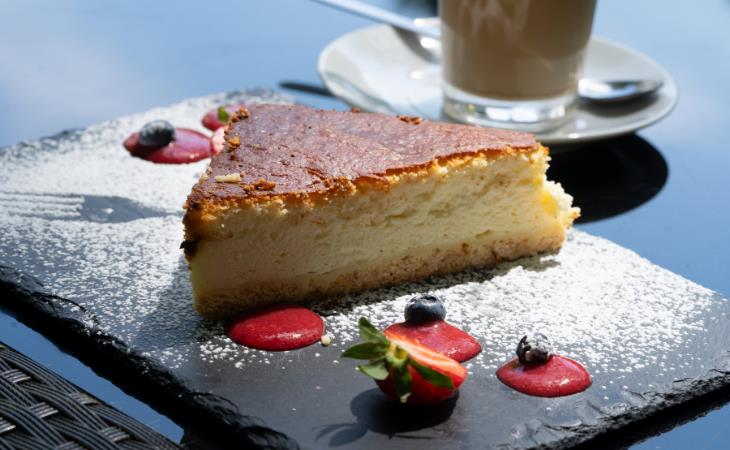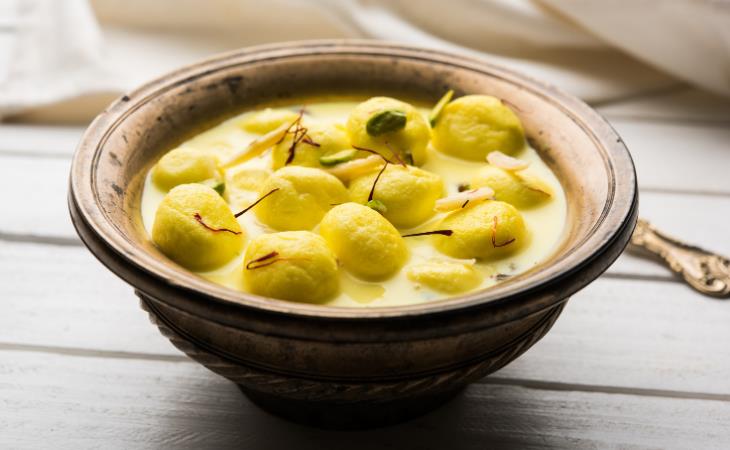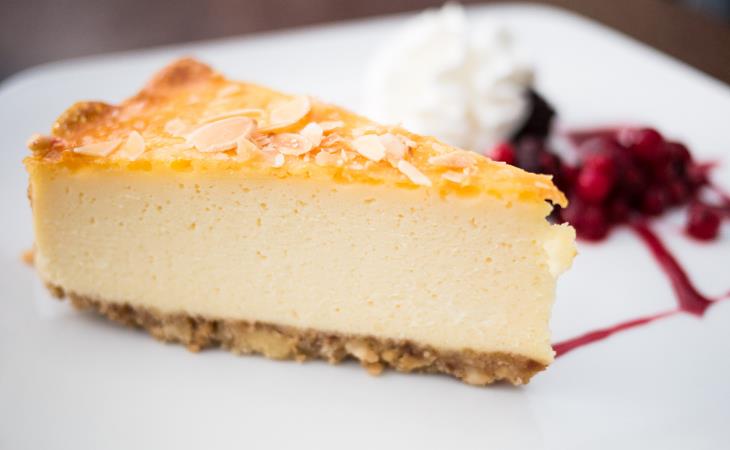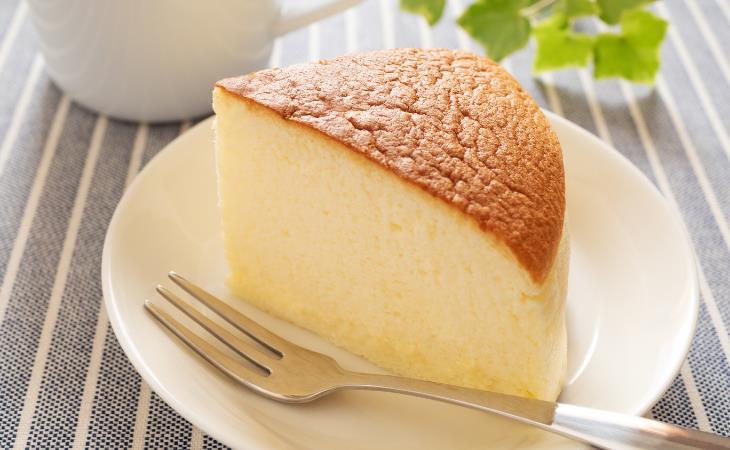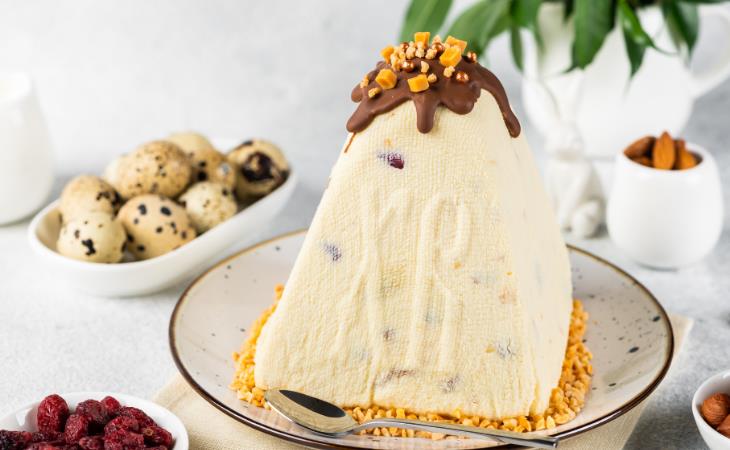Sernik is a traditional Polish cheesecake that holds a significant place in Polish culinary heritage. It's made from eggs, sugar, and twaróg, a curd cheese that has long been used in dessert-making traditions. Legend has it that Sernik originated in the 17th century, when King Jan III Sobieski introduced the recipe after his victory over the Turks at the Battle of Vienna. Sernik has evolved into several variants, from baked to unbaked, with a crumbly cake base.
2. Ras Malai – India
Ras malai is a delectable Indian dessert that consists of soft, flattened cheese dumplings soaked in a creamy, sweetened milk syrup flavored with cardamom and saffron. The cheese dumplings, also known as "malais," are typically made from paneer (Indian cottage cheese), kneaded until smooth, and then shaped into small patties. The patties are then gently poached in milk, sugar, and aromatic spices until soft and spongy. Once prepared, ras malai is cooled and served cold, topped with chopped nuts like pistachios or almonds. Its rich, creamy texture and subtle flavors make it a popular dessert for festivities and special occasions in India.
3. Sfakianopita – Greece
Sfakianopita, also known as Sfakia pie, is a traditional Greek dessert originating from the region of Sfakia in Crete. It's a rustic but flavourful pastry made with simple ingredients like wheat, olive oil, and honey. The dough is stretched thin and folded over a filling of local cheeses, usually mizithra or graviera, before being fried or baked till golden brown. Once cooked, sfakianopita is often drizzled with honey and sprinkled with cinnamon, adding a sweet and aromatic finish to this beloved treat. Aside from its delectable flavor, this sweet dish is also cherished for its cultural significance, as a symbol of the culinary traditions of the Sfakian people as well as the island of Crete in general.
4. New York-style cheesecake – USA
New York-style cheesecake is a rich and indulgent dessert that has become popular all over the world. Originating in New York City, this classic cheesecake is distinguished by its dense and creamy texture, achieved through the use of cream cheese as the main ingredient. Unlike classic cheesecakes, New York-style cheesecake has a thicker and denser filling, which is baked to perfection over a buttery Graham cracker base. It has a silky, smooth consistency and a slightly tangy flavor profile. This cheesecake is often served plain or with a simple fruit topping, and has established itself as a treasured dessert classic.
5. Japanese cheesecake – Japan
Japanese cheesecake, also known as "cotton cheesecake" or "soufflé cheesecake," is a light and scrumptious delicacy that has gained popularity worldwide. Unlike traditional cheesecakes, Japanese cheesecake has a light and fluffy texture similar to a soufflé. It's made with cream cheese, eggs, sugar, and a small quantity of flour, all whisked together to make a smooth and creamy batter.
The secret to its unique texture is the method of preparation, which involves mixing beaten egg whites into the cheesecake batter to add volume and lightness. Japanese cheesecake is often baked in a water bath to achieve consistent cooking and moistness. This results in a delicate, melt-in-your-mouth dessert that is adored for its subtle sweetness and cloud-like consistency.
6. Rákóczi túrós – Hungary

Rákóczi túrós, or Rákóczi cottage cheese cake, is made up of a rich and creamy filling of cottage cheese. It's sweetened with a small amount of sugar, flavored with various flavors like vanilla extract or lemon zest, and encased in a delicate and flaky pastry crust. The cottage cheese filling is often enhanced with the addition of eggs, semolina, and sometimes sour cream, which gives it a smooth and velvety texture.
Rákóczi túrós is baked until the crust is golden brown and the filling is set, creating a appetizing contrast of flavors and textures. This popular delicacy is enjoyed throughout Hungary, particularly on holidays and special events.
7. Míša řezy – Czech Republic
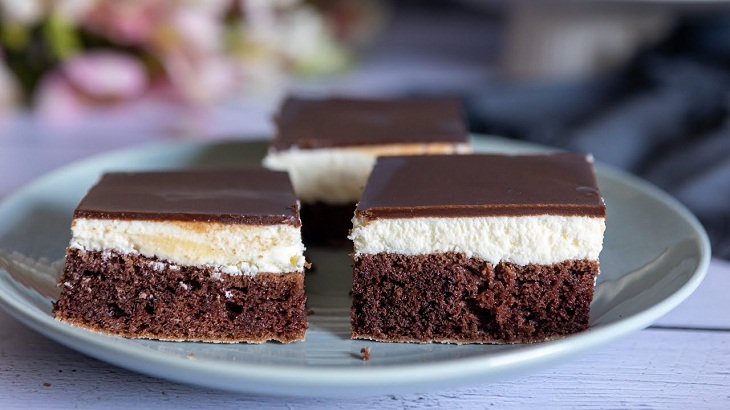
Míša řezy, or "Míša slices," are delicious Czech desserts made of chocolate sponge cake layers filled with a creamy mixture typically made from butter, condensed milk, and cocoa powder. These layers are stacked and coated with a smooth chocolate ganache, resulting in a rich and indulgent treat.
The name "Míša" is often attributed to the dessert's resemblance to slices, with its layered construction and smooth chocolate exterior. Míša řezy is loved for its harmonious blend of flavors and textures and offers a satisfyingly sweet experience with every bite.
Related: 14 Dreamy Dessert Articles for Every Taste and Preference
8. Cartola – Brazil
This beloved traditional Brazilian sweet treat is made of thinly sliced bananas that are cooked till golden and caramelized. The bananas are then drizzled with molasses or honey and topped with cinnamon for additional flavor and aroma. To complete the dish, it is often served with a scoop of creamy vanilla ice cream. Cartola is cherished for its simplicity and promises a mouth-watering gastronomic experience.
9. Quesada pasiega – Spain
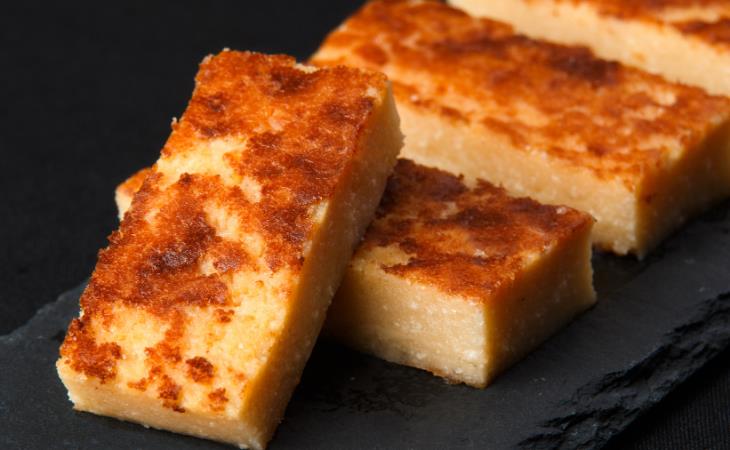
Quesada pasiega is a popular Spanish sweet dish known for its creamy texture and rich flavors. This yummy cake is made with butter, sugar, milk, flour, eggs, and either ricotta or cheese curds, with touches of cinnamon and lemon zest for extra richness. Quesada pasiega resembles a dense pudding and can be eaten hot or cold, giving you more options for serving. To enhance its already delectable taste, it's often recommended to accompany it with fruit jams.
10. Paskha – Russia
Paskha is a Russian delicacy consisting of farmer's cheese, butter, sugar, egg yolks, cream, and vanilla, which gives it a rich and creamy texture. A traditional Easter treat, its pure white hue represents Christ's purity and the Paschal Lamb's sacrifice. Designed as a pyramid but with its apex removed, it can be viewed as representing either the Church or the Tomb of Christ. Paskha is also adorned with religious elements like crosses or inscriptions. Additional embellishments, such as nuts, dried fruits, or floral accents, add to its visual appeal. Paskha is often taken to churches for blessings and eaten alongside the traditional Easter bread, kulich.

